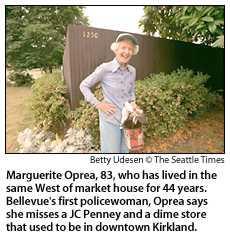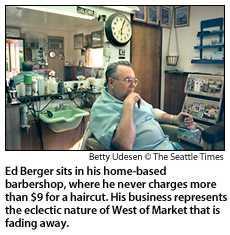|
|
|||
|
|
Monday, November 20, 2000, 8:00 a.m. Pacific
One neighborhood and its identity crisis By Stuart Eskenazi
|
|||||||||||||||||||
|
Gentrification once meant the migration of middle-class people into an urban neighborhood that had been decaying. But 10 years of unprecedented prosperity in King County, swelling the ranks of the wealthy, has redefined the word.
Now, it can be used to describe what's happening in King County's affluent suburban neighborhoods. West of Market, for one, is morphing from a place where middle-class people laid down roots into a habitat for the new rich.
The longtime residents live comfortably but seem demoralized by new wealth displayed as the massive houses next door.
"When you live in a small, two-bedroom bungalow and somebody builds what can only be called a megahouse right next to you, it is just plain intimidating," says Tere Gidlof, president of the Market Neighborhood Association.
The old-timers say they struggle to relate to their new neighbors, whom they perceive as pretentious. The perceptions may be imagined, but seem real to them.
'They're building such big houses. With no Yard! Nobody's home to enjoy it; they both work.' |
Eric Horvitz seems apologetic that his 5,810-square-foot house looks huge from the street. "It's not very big inside," he says.
The castes are clashing.
Ellen Lutz lives in a West of Market house her parents bought in 1946. She repeats a familiar refrain: Old neighbors know their new neighbors only through the buzzing sounds of automatic garage doors opening and closing.
"You get to know their yard man when you're working on your own bushes," she says.
Seniors, young families gone
For more than 25 years, Barbara Loomis has lived in a house built in 1889 for a steel worker. The walls stage nifty antique moldings, and the front porch meanders across the full width of the house.Loomis remembers when she could stand at her kitchen window every Sunday morning at 10 to watch three elderly neighbor men ramble across the street to meet for coffee at one of their houses.
The three neighbors are gone now, as are most of the seniors and young families of modest means, she says.
"This used to be a neighborhood where young families could buy a fixer-upper house and turn it into their dream house over time," says Loomis, a preservationist active in the Kirkland Heritage Society. "Now, the fixer-uppers are just torn down."
 The gentrification of West of Market began in 1990 when real estate agent Fay Besharat listed a new Italian-style villa designed by her husband at the time. The price: $499,000.
The gentrification of West of Market began in 1990 when real estate agent Fay Besharat listed a new Italian-style villa designed by her husband at the time. The price: $499,000.
"Everyone thought we were crazy and would say, 'What the heck are you doing building a house like this in a neighborhood like that?"' recalls Besharat. "It sat on the market forever, and finally we bought it because I couldn't sell it. Everybody in the neighborhood was happy we bought it because it was a sign this growth and change wasn't going to happen."
Wistful memories of wishful thinking.
Since 1991, nearly one-fifth of the 500 residential lots in West of Market have undergone face-lifts, Kirkland records show. Twenty-six smaller houses have been torn down and replaced with larger new homes. In addition, 43 older houses have been remodeled with a second story or other major addition. An additional 19 homes have been built on lots where no house stood.
Developers converged on West of Market in the 1990s, persuading owners of tiny homes to cash in on their most valuable asset: their land. The developer then would flatten the house and build a fancier home. After it sold, the builder thenmoved to the next deal.
"I think you would call those people carpetbaggers," Gidlof says. "My, that's a nasty word."
But just the kind of word that slips out from someone sensing something dear slipping away.
"It's so hard for people who have invested their lives and raised their families in this neighborhood -- and they're all getting older -- to wake up every Monday morning to a bulldozer taking down homes younger than they are," Gidlof says. "What does that do to you?"
Houses 'aren't worth saving'
West of Market residents like to refer to the neighborhood's "Seattle feel," an allusion to its grid street layout and variety of home designs. The neighborhood is within walking distance of downtown Kirkland.
The proximity appealed to George Noble, an American Airlines pilot who bought a 58-year-old ramshackle house along the water in 1993 and tore down all but one wall in building his 3,400-square-foot home.
"A lot of these houses being torn down, let's face it, aren't worth saving," says Noble, one of the first to harvest in West of Market.
Noble's jet-set lifestyle is enviable. On Friday, he arrives at the airport to work. On Saturday, he's taking a casual jog behind the Eiffel Tower. His garage is stuffed with a sailboat, two classic sports cars and a vintage motorcycle.
Noble grew up as one of five children in a blue-collar family in Everett. The son of a carpenter, he owns a construction company that builds rental houses. He takes pride at knocking down an old house himself and helping build a new one.
"It's a real stretch for me to hire someone to cut my grass," says Noble, who succumbed. "I got tired of the fact that every time I got back from a trip, the first thing I had to do was my lawn. But I still do my own weeding."
The West of Market house where Gidlof has lived more than 30 years has 780 square feet of living space and was built in 1921 as a summer cabin.
Gidlof, 54, an administrative assistant for a salesman , has scant extra money but a valuable asset in her land. Selling the asset may make financial sense, but the toll would be traumatic. West of Market is the only neighborhood Gidlof has ever really known.
"For working-class people, the option to live out their retirement in the home they have lived in for a lot of years has been virtually taken away," Gidlof says.
"The value of the property is so high that it would be foolish to not capitalize on it. I can stay in my house, pay the high taxes, live very modestly and keep the yard in the shambles it's in. Or I can sell my house, take the profits, move and have a much nicer house with money in the bank."
About three years ago, a woman who moved into a big new West of Market house called Gidlof to ask how she could get involved in the neighborhood association. This thrilled Gidlof because she believed her affluent new neighbors weren't interested in such things.
But then the woman told Gidlof she wanted the association to emphasize "neighborhood standards."
"I skirted the issue, being an abject coward," Gidlof says. "I'd be the first person they'd go after."
| Background, Related Info & Multimedia: |
|
| The percentage of houses over 3,000 square feet | |
| The size of the average new King County house has nearly doubled | |
| A tale of two neighborhoods |
![]()
| [ seattletimes.com home ] [ Classified Ads | NWsource.com | Contact Us | Search Archive ] |
